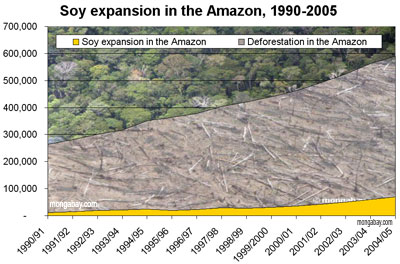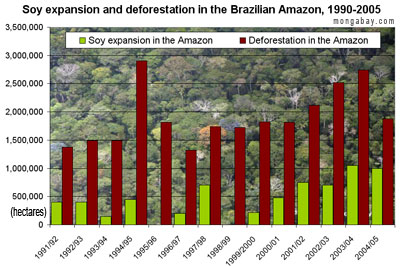Amazon soy moratorium extended; may be expanded to other products
Amazon soy moratorium extended; may be expanded to other products
mongabay.com
June 23, 2008
|
|
Soy crushers operating in the Brazilian Amazon have extended a two-year-old moratorium on the purchase of soybeans produced on rainforest lands deforested after 2006, reports Reuters.
The agreement — signed by members of Brazilian Vegetable Oils Industry Association (Abiove), a soy industry group that accounts for 94 percent of Brazil’s soy crush — extends the ban through July 23, 2009.
Brazil’s environment minister Carlos Minc said the government is working on similar agreements for saw mills, slaughterhouses, and steel mills operating in the Amazon.
“The moratorium is a successful initiative by civil society and the soya industry. The Federal Government is entering the process now and is committed to register and license all rural properties in the Amazon biome,” Minc was quoted as saying by Reuters. “Inspired by the success of this initiative, the Brazilian government is negotiating similar approaches with the timber and beef industries.”
The agreement comes amid a wider effort by the Brazilian government to improve governance and promote sustainable development in the Amazon region in response to a spike in deforestation during the second half of 2007. Brazil recently cracked down on illegal operations in the Amazon, seizing and selling contraband timber and agricultural products. At the same time the government has offered low interest loans to ranchers, farmers, and loggers who work to minimize their impact on the environment.
Support from a traditional critic
The extension of the moratorium was welcomed by Greenpeace, an environmental group that played a key part in pressuring the soy industry for its role in deforestation.
 Soy expansion in the Brazilian Amazon, 1990-2005 Total deforestation and area of soybean cultivation across states in the Brazilian Amazon. Overall soybean cultivation makes up only a small portion of deforestation, though its role is accelerating. Further, soybean expansion and the associated infrastructure development and farmer displacement is driving deforestation by other actors. Note: some soybean farms are established on already degraded rainforest lands and neighboring cerrado ecosystems. Therefore it would be inappropriate to assume the area of soybean planting represents its actual role in deforestation.  Annual deforestation rates and annual soy expansion for states in the Brazilian Amazon 1990-2005. Note that the 1995-1996 and 1998-1999 years were negative and do not show up on the chart. Graphs based on Brazilian government data. |
“The decision to extend the moratorium against the backdrop of rising commodity prices and the food crises shows that government and industry now understand that it is possible to protect the forest, combat climate change and still ensure food production,” said Paulo Adario, campaign director for Greenpeace in Brazil.
“We are delighted to see the new environment minister take an active role in ensuring the continuation of the moratorium. Such high level support helps Abiove and the traders convince farmers to support the initiative. His support also serves as a warning to those who continue to destroy forests that their soya will be rejected by the market.”
Greenpeace said that McDonalds, Wal-Mart and Carrefour also supported the extension of the moratorium.
The moratorium’s results
Abiove and Greenpeace say the moratorium has been effective at reducing new rainforest clearing for explicit soy production. A joint report released in April found no new soybean plantations in any of the 193 areas that showed deforestation of 100 hectares (250 acres) or more between August 2006 and August 2007.
Nevertheless despite the moratorium, some observers say soy continues to be an important indirect driver of deforestation in the Brazilian Amazon by driving up land prices and creating an impetus for infrastructure improvements that promote forest clearing. In areas where soils and topography are suitable for mechanized soy cultivation, rainforest lands are typically cleared for low-intensity cattle ranching then sold to soy producers some two to three years later. Ranchers then move into frontier areas, spurring deforestation.